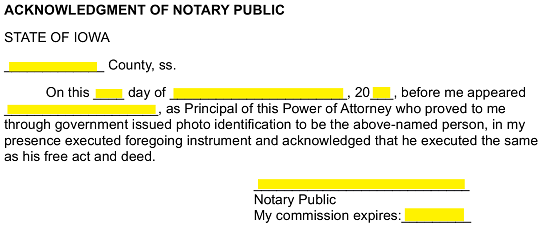Updated August 08, 2023
An Iowa general power of attorney allows an individual to properly identify another as his or her attorney-in-fact or agent. It simultaneously defines what a delegated agent may do in the principal’s name and supplies official proof of their approval of those actions. This is similar to the durable power of attorney, except that it becomes void and ineffective if the principal becomes mentally or physically incapable of handling their own matters. The rationale is that they are incapable of revoking the document at that point, so rather than allowing an agent to take advantage of their incapacity, the document is void. This, of course, is upon the approval of the individual issuing this document. In fact, every point that should apply to the attorney-in-fact will have to be defined within the contents of this form then be approved through the signature of the principal.
Laws
- Statutes – Chapter 1078 Uniform Power of Attorney Act
- Authority (I.C.A. § 633B.201) – An agent under a power of attorney may act on behalf of the principal and exercise broad authority as granted by the agreement.
- Signing Requirements (I.C.A. § 633B.105) – The principal is required to acknowledge their signature in the presence of a notary public.
How to Write
Download: PDF, MS Word, OpenDocument
1 – The Principal’s Legal Name Must Be Included In The Title
Locate the title of this form at the top of the first page. Then, on the blank line present, enter the Legal Name of the Grantor or Principal.  This action should be repeated on the first blank space of the first paragraph. Make sure to re-enter the Legal Name of the Grantor or Principal on this line.
This action should be repeated on the first blank space of the first paragraph. Make sure to re-enter the Legal Name of the Grantor or Principal on this line.  Once this task is completed, record the Legal Address (Building Number/Street/Unit Number/County) of the Principal on the second blank space.
Once this task is completed, record the Legal Address (Building Number/Street/Unit Number/County) of the Principal on the second blank space.  The report on the Principal’s Identity will conclude with the State where the Principal’s Legal Address is located.
The report on the Principal’s Identity will conclude with the State where the Principal’s Legal Address is located.  Now, find the word “…designate.” Fill in the Full Name of the Attorney-in-Fact or Principal Agent on the blank space that follows it.
Now, find the word “…designate.” Fill in the Full Name of the Attorney-in-Fact or Principal Agent on the blank space that follows it.  Similarly, to the Principal’s information, the Legal Street Address where the Attorney-in-Fact resides.
Similarly, to the Principal’s information, the Legal Street Address where the Attorney-in-Fact resides. 
Finally, enter the State where the Attorney-in-Fact maintains his or her residence on the last blank line in this paragraph.
2 – The Principal’s Deliverance Of Power Must Be Specified
Generally, it is a good idea to describe the Principal Powers delivered to an Agent. By providing a clear definition, future miscommunications may be prevented. Thus, the Principal should go through the “Powers” list in the second section, then initial each numbered statement that defines the types of Power, Decisions, and Actions, the Principal Agent may engage in on the Principal’s behalf. Any item on this list that is not initialed by the Principal by the time the Notarized Principal’s Signature occurs will not be delivered to the Agent through this document.
Paragraph Number One will define how the Attorney-in-Fact may go about making Payments and Collecting Money on the Principal’s behalf with the defined Authority. The Principal should initial this paragraph if he or she wishes to grant the defined Powers to the Principal Agent.
Statement Number Two provides a definition of the manner in which the Principal’s Attorney-in-Fact may Acquire, Lease, and Sell Property in the Principal’s Name. The Principal will empower the Agent to engage in all the defined actions described in this item, once he or she initials the blank space.  The Third Statement describes the Powers the Principal Agent may employ to Acquire, Lease, and Sell the Principal’s Real Property. This ability will only be approved by the Principal initialing the blank space provided.
The Third Statement describes the Powers the Principal Agent may employ to Acquire, Lease, and Sell the Principal’s Real Property. This ability will only be approved by the Principal initialing the blank space provided.  The Fourth Paragraph defines the Management Powers that will be designated to the Principal Agent upon the Principal’s initialing of the blank space preceding the Number Four.
The Fourth Paragraph defines the Management Powers that will be designated to the Principal Agent upon the Principal’s initialing of the blank space preceding the Number Four.  Paragraph Number Five will designate Banking Powers (in relation to the Principal’s Banking) to the Attorney-in-Fact. This item should be initialed by the Principal should the Agent have this Authority delivered to him or her.
Paragraph Number Five will designate Banking Powers (in relation to the Principal’s Banking) to the Attorney-in-Fact. This item should be initialed by the Principal should the Agent have this Authority delivered to him or her.  Statement Number Six will define the Agent’s Principal Powers over the Principal’s Motor Vehicles. This Authority will be delivered to the Agent by the Principal’s initials on the blank line.
Statement Number Six will define the Agent’s Principal Powers over the Principal’s Motor Vehicles. This Authority will be delivered to the Agent by the Principal’s initials on the blank line.  The Agent may wield Principal Tax Powers, as defined in Paragraph Number Seven when the Principal initials the blank space preceding the Number Seven.
The Agent may wield Principal Tax Powers, as defined in Paragraph Number Seven when the Principal initials the blank space preceding the Number Seven. 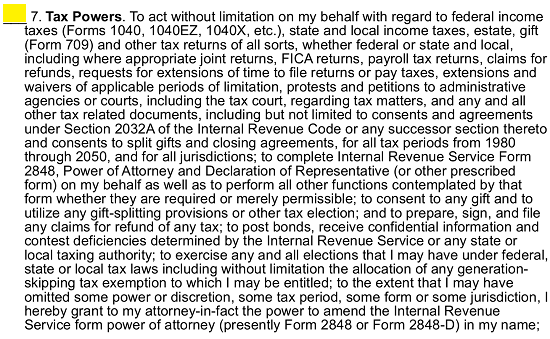 The Principal will deliver the Powers defined in Statement Number Eight to the Agent, once he or she initials the blank space. This item will define Powers regarding the Principal’s Safe-Deposit Boxes.
The Principal will deliver the Powers defined in Statement Number Eight to the Agent, once he or she initials the blank space. This item will define Powers regarding the Principal’s Safe-Deposit Boxes.  Paragraph Nine defines how the Agent may employ Gift Making Powers on behalf of the Principal. In order for the Principal to designate these Powers to the Agent, he or she must initial this item.
Paragraph Nine defines how the Agent may employ Gift Making Powers on behalf of the Principal. In order for the Principal to designate these Powers to the Agent, he or she must initial this item.  Statement Number Ten shall provide a description of the Lending and Borrowing Powers the Attorney-in-Fact will assume once the Principal initials this statement.
Statement Number Ten shall provide a description of the Lending and Borrowing Powers the Attorney-in-Fact will assume once the Principal initials this statement.  The Agent will have Principal Powers in the Principal’s Contracts, as per Statement Number Eleven, once the Principal initials the space provided.
The Agent will have Principal Powers in the Principal’s Contracts, as per Statement Number Eleven, once the Principal initials the space provided. ![]()
Paragraph Number Twelve describes the Health Care Powers that will be designated to the Agent through the Principal’s initials on this item.  Statement Number Thirteen empowers the Attorney-in-Fact to act as a Principal Representative as per the Health Insurance Portability and Accountability Act of 1996 (Pub. L. No. 104-191) upon the Principal’s initialing of this item.
Statement Number Thirteen empowers the Attorney-in-Fact to act as a Principal Representative as per the Health Insurance Portability and Accountability Act of 1996 (Pub. L. No. 104-191) upon the Principal’s initialing of this item.  The Agent will have the Principal’s Approval in Hiring and Paying for Services in the Name of the Principal. These acts will be defined in Paragraph Number Fourteen. If the Principal wishes to designate such Powers to the Attorney-in-Fact, he or she should initial the fourteenth item.
The Agent will have the Principal’s Approval in Hiring and Paying for Services in the Name of the Principal. These acts will be defined in Paragraph Number Fourteen. If the Principal wishes to designate such Powers to the Attorney-in-Fact, he or she should initial the fourteenth item.  The Agent may collect Reimbursement as per Statement Number Fifteen, it the Principal initials this item.
The Agent may collect Reimbursement as per Statement Number Fifteen, it the Principal initials this item. ![]() Statement Number Sixteen describes the types of Actions the Agent may take to sue Third Parties who do not respect the Principal’s designation of Authority. If the Principal intends for the Attorney-in-Fact to have this Power, he or she should initial this item.
Statement Number Sixteen describes the types of Actions the Agent may take to sue Third Parties who do not respect the Principal’s designation of Authority. If the Principal intends for the Attorney-in-Fact to have this Power, he or she should initial this item.  Item Number Seventeen will provide several blank lines. If the Principal has any additions to the above Authority descriptions the Agent should be designated with, such Powers may be declared here. The Principal must also initial this item on the space preceding the Number Seventeen if any Principal Preferences/Instructions are documented here.
Item Number Seventeen will provide several blank lines. If the Principal has any additions to the above Authority descriptions the Agent should be designated with, such Powers may be declared here. The Principal must also initial this item on the space preceding the Number Seventeen if any Principal Preferences/Instructions are documented here.
3 – The Start Date And Termination Date Must Be Clearly Stated
The “Effective Date and Termination” area will seek to define first, the Start Date or Event when the Principal Powers in this document are officially delivered to the Agent then, a definition to the Termination Date or Event these Principal Powers are no longer available to the Agent. This determination will be presented with the Principal initialing the appropriate choice.
First, let us solidify the Start Date or Event. If the Principal Powers will be delivered upon the Principal’s act of signing this form, the Principal should initial the first choice. 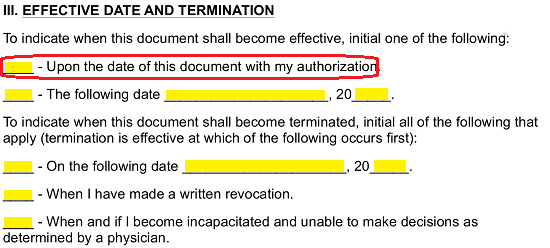 If the Principal Powers will be delivered only upon a certain Date, the Principal will need to initial the second choice and enter the Date the Principal Powers should be appointed to the Agent.
If the Principal Powers will be delivered only upon a certain Date, the Principal will need to initial the second choice and enter the Date the Principal Powers should be appointed to the Agent. 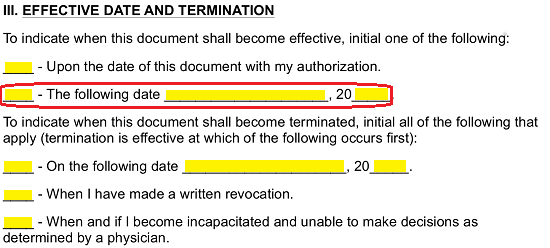 Next, we shall deliver the Principal’s wishes as to when the Powers defined in this document will be stripped from the Agent so that he or she may no longer act as such. If the Termination of these Principal Powers occurs automatically at a future Date, the Principal should enter the Termination Date just after the words “On the following Date.” Then, he or she must initial this item.
Next, we shall deliver the Principal’s wishes as to when the Powers defined in this document will be stripped from the Agent so that he or she may no longer act as such. If the Termination of these Principal Powers occurs automatically at a future Date, the Principal should enter the Termination Date just after the words “On the following Date.” Then, he or she must initial this item. 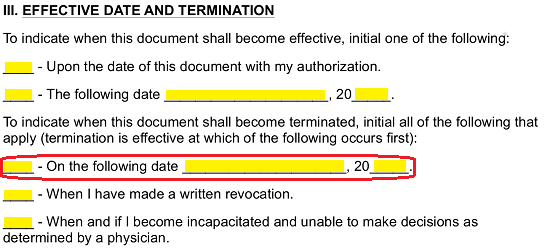 If the Termination of Principal Powers occurs when the Principal has revoked this document in writing, then initial the blank space just before the term “When I have…”
If the Termination of Principal Powers occurs when the Principal has revoked this document in writing, then initial the blank space just before the term “When I have…” 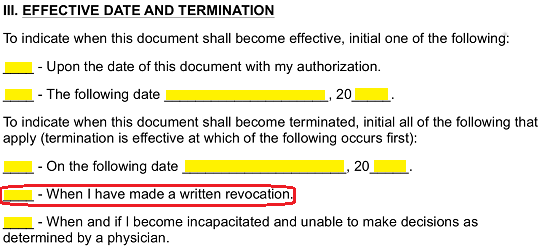 If this document’s Termination Date is whenever the Principal is incapacitated, the Principal should initial the third choice.
If this document’s Termination Date is whenever the Principal is incapacitated, the Principal should initial the third choice. 
4 – The Principal Signature Is Required By This Form
Next, the Principal should review this entire document at least once or twice. When this form has been verified as containing accurate information, the Principal, Agent, and Notary Public should decide upon a Signing Date, then meet and executed this document through a Notarized Principal Signature.
This form must have the exact Date of signing entered in the “In Witness Whereof…” statement.  Below the reported Date of Signature, the Principal must sign and print his or her name (Print Name below Signature). There will be two separate spaces provided for this.
Below the reported Date of Signature, the Principal must sign and print his or her name (Print Name below Signature). There will be two separate spaces provided for this.  The “Acceptance Of Appointment” statement is next. The Attorney-in-Fact must read this statement then display his or her Acceptance by Signature. First, make sure the Attorney-in-Fact’s Name is printed on the blank line of this paragraph. Once this is done and the Attorney-in-Fact is ready, he or she must supply his or her Signature and Printed Name in the spaces provided.
The “Acceptance Of Appointment” statement is next. The Attorney-in-Fact must read this statement then display his or her Acceptance by Signature. First, make sure the Attorney-in-Fact’s Name is printed on the blank line of this paragraph. Once this is done and the Attorney-in-Fact is ready, he or she must supply his or her Signature and Printed Name in the spaces provided.  Finally, the Notary Public viewing this signing will provide any further instruction, then fill out the “Acknowledgment Of Notary Public” section.
Finally, the Notary Public viewing this signing will provide any further instruction, then fill out the “Acknowledgment Of Notary Public” section.